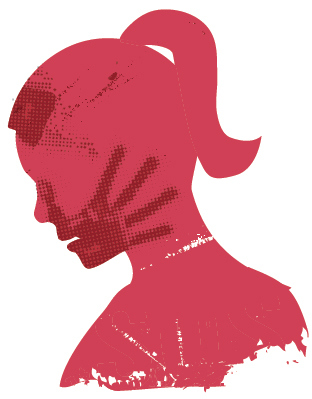
Due to concerns about privacy, none of the interviewees’ names will be mentioned in this article, with the exception of one university official. The term ‘sexual harassment’ represents all kinds of verbal, emotional, and physical actions which offend people’s sexuality and make them feel humiliated, offended or discriminated because of their gender, as defined by the University of Seoul (UOS) regulations for the prevention and discipline of sexual violence.
According to the Chosun Ilbo, Seok-jin Kang, a mathematics professor at Seoul National University, was caught in 2015 after four years of habitual molestation. The professor sexually harassed at least seven female students that he had been advising. The Supreme Court sentenced him to two and a half years in prison along with a 160-hour sex offender treatment program and a three-year public disclosure of his identity on the online sex offender database. This sentence did not take into account similar misdeeds he had committed from 2008 to 2009, since habitual molestation was not yet indictable at that time. This news was even more shocking considering his upstanding status as an esteemed mathematician whose book has been used as teaching material at Harvard University. Furthermore, as more victims started to attest to Kang’s crimes in online communities, it was reported that he had been harassing students since as early as 2004.
It is not only authority figures who commit these misdeeds. In 2011, three students from Korea University’s College of Medicine molested a female student together during a party. According to Chosun Ilbo, the assailants undressed and fondled the victim, who had passed out after consuming alcohol, and two of them even took pictures of her naked. The online news provider Pressian reported that before the trial, the accused students tried to carry out a campaign of character assassination against the victim, conducting a survey consisting of items such as “The victim has been sexually promiscuous: Yes/No.” After a year-long trial which went all the way to the Supreme Court, two of the medical students were sentenced to 18 months in prison, and the third to 30 months.
The places in which harassment occurs are not limited to the real world, but also extend to online chat rooms. The Kukmin Daily reported that this year dozens of male students at Yonsei University have verbally and sexually offended fellow female students in a Kakao Talk chat room. According to the newspaper, an official of the university commented simply that the university will react as the investigation proceeds.
Unfortunately, UOS is not an exception to on-campus sex crime. YTN reported that in 2013, the president of the Student Council resigned his post after admitting to harassment of a female student. In addition, many students have been visiting the UOS Student Counseling Center to report cases of sexual harassment up to this day. In some cases, the investigations carried out by the Center and other university bodies have even led to the charging of offenders.
The UOS Times interviewed Ms. A, a victim of sexual harassment, under the condition of anonymity. She was a student who volunteered to help at an event held on campus, and was sexually harassed by a male staff member. During the event, distinguished guests were required to have name tags pinned to their chests, but instead of telling the volunteers to instruct the guests to pin the tags on themselves, the male staff member ordered the volunteers to personally pin the name tags onto the guests’ chests. “He also told us that only pretty girls can sit in the front,” Ms. A said. When she was sitting in a chair near the front, the staff member told her to move away and busy herself elsewhere because she was not pretty. Ms. A said, “At that moment I was too embarrassed to express my anger. I had no choice but to giggle along with him. Later, I found it to be a very upsetting moment.”
Ms. B, another sexual harassment victim who requested anonymity, was harassed by a male UOS student on Facebook. When she uploaded some simple posts about her summer vacation and an outfit she had worn, the male student wrote inappropriate replies about her, expressing a desire to see her in this outfit. She and other friends immediately complained about the impropriety of his response and requested an apology. Ms. B added, however, that he didn’t seem to regret his actions, and that hurt her.
Ms. B was also tormented by the inappropriate behavior of one of her professors. According to her, throughout the semester the professor was paying too much attention to her and kept inviting her to private parties. Once, she had to meet the professor to submit a document accounting for her absence from class, and the professor pinched her nose and cheek. She felt “so angry and uncomfortable.”
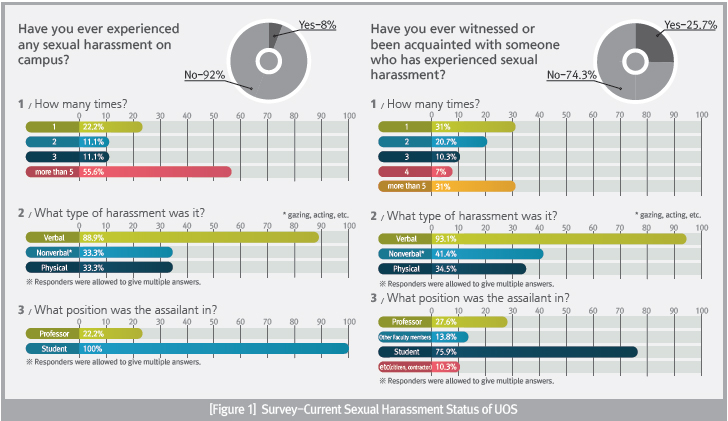
Current Status of On-Campus Sexual Harassment at UOS
These cases of Ms. A and Ms. B are not just isolated incidents. Actually, it seems that sexual harassment at UOS is getting more and more severe despite efforts to improve the situation. Sang-soo Kim, a counselor at the UOS Student Counseling Center, said, “Though I can’t give the exact number of students who have been through sexual harassment or experienced other incidents on campus, it is growing every year, and the severity of cases is also getting more intense. Compared to the situation at other universities, including cases that are not publicly filed, the situation at UOS is not really on the bright side.” Kim is in charge of counseling both victims and offenders when sexual violence and other forms of harassment occur.
Counselor Kim alluded that exact statistics of sexual harassment reporting and counseling at universities are basically considered top secret. According to the Yonhap News Agency, universities do not like to provide detailed information about on-campus sex crime, not only for the protection of involved parties, but also due to concerns about the reputation of the university. In order to gather information about these incidents directly, The UOS Times conducted an online survey with more than 100 respondents, which included students of various ages from different departments. The respondents, 52 percent of whom were male and 48 percent female, ranged from freshmen to graduate students.
According to the results of the survey as seen in Figure 1, only about eight percent of the respondents have had direct experience of sexual harassment. However, when it comes to indirect experience, 25.7 percent responded that they have witnessed or are acquainted with someone who has experienced sexual offence, from harassment to more severe cases.
Counselor Kim pointed out that on-campus sexual harassment is more common than most students might realize. “Many students tend to consider that what they hear on the news describes everything,” he said. “But in fact they are underestimating the situation, since there are far more students secretly coming to the center to get help after suffering different degrees of sexual harassment. And news of only a few of these cases, usually the most severe ones, is released to the public.”
On the survey, 55.6 percent of the students who have directly experienced sexual harassment said that it has happened more than five times, while only 22 percent experienced it only once. In the case of people who have indirectly experienced harassment, five times or more was also the most common response. As for the types of sexual harassment, verbal was the most common type for both groups, followed by non-verbal harassment such as inappropriate gazes or gestures, and the physical type was the third most common.
When it comes to the position of perpetrators, about 80 percent of the total victims?including both direct and indirect?answered that it was a fellow student who had harassed them. The aforementioned Ms. B said that, “one day, my friends lighted upon a Kakao Talk chat room for male students, which is almost the same as the one reported on the news as evidence of sexual harassment.” Kim also confirmed that most on-campus sexual harassment at UOS happens between students, with incidents between faculty and other school members being very rare.
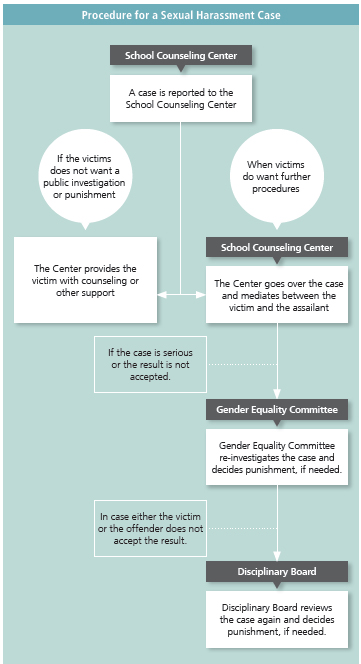
What Procedure is Taken for Sexual Harassment Cases?
Once sexual harassment occurs and the victim visits the Student Counseling Center, he or she can choose whether or not to formally file the case so that it can be investigated and punishments can be levied, if needed. Once the case is formally filed, the center starts investigating the case, gathering information about the alleged assailant and the details surrounding the incident. Further measures including disciplinary action can be taken if the officials judges that the severity of the case calls for it. On the other hand, if the case is not formally filed, the center does not publicly start an investigation or call for disciplinary action, but only provides the victim with counseling and other support.
If an investigation begun, the counselor must keep the victim and the assailant separated for its duration in order to prevent unwanted further incidents. After the investigation has been concluded, the Counseling Center can take necessary punitive measures, which could include a restraining order. At the same time, the counselor can provide the assailant with on-site training and education designed to prevent these types of incidents from recurring.
If the assailant or victim makes an appeal or if the case is severe, the Center can refer the case to the Gender Equality Committee, which consists of students, professors, and university officials. This committee is designed to have both male and female members for each post, in order to reflect various opinions from different positions and genders.
In the case that either the victim or the offender is still not satisfied after a decision has been made by the Gender Equality Committee, the case is referred to a disciplinary board. These days, according to the Student Counseling Center, the university officials that serve on this board deliberately try to punish offenders harshly if they are found guilty of sexual harassment after the investigatory process has been concluded. The university administration, Kim Said, hopes that these punishments can serve as warnings to others who have inappropriate thoughts in their mind, and deter them from inflicting pain on potential victims.
According to Counselor Kim, however, the whole process of counseling and discipline is entirely up to the victims. If they just want private counseling, then that is as far as the Center will take the case. The Counseling Center is not obligated to investigate the incident against the victim’s will. He said, “I have heard that many victims haven’t come to the center but just suffered alone instead, because they were worried that somehow their privacy would violated, or that their friends and family would see them differently if they found out about what had happened. And some of them are worried about retaliation by the assailant, too.” He explained that because the whole process is victim-friendly, it is actually the offender who should worry about these things, not the victim.
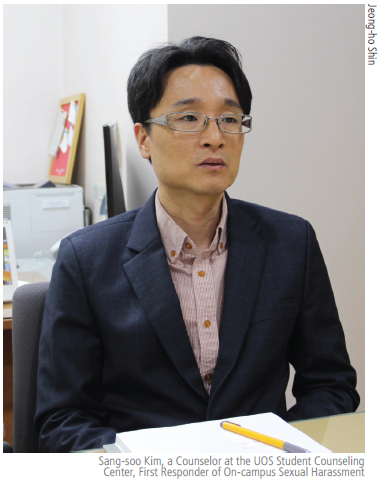
Why does Sexual Harassment Happen?
From an academic point of view, Seon-hui Heo says in her article entitled Research on Prevention of Sex Crimes and Second Offense that there are two types of reasons behind sexual violence: personal and environmental. The personal reasons include biological, physical, and mental factors such as hormonal imbalance, sexual dysfunction, and improper education in childhood. The environmental reasons are related to sexually violent culture, including overexposure to sexually explicit media in adolescence, as well as the social environment of Korea that is still male oriented.
In the survey, UOS students showed various responses about the reasons for sexual harassment. The most frequently appearing ones were “wrong sexual perception” and “lack of sexual education and discipline.”
In terms of sexual perception, one reply pointed out that old-fashioned ideas, according to which physical contact or sexually biased jokes are still acceptable, still lie within people’s subconscious. Another reply also said that some people are just unaccustomed to the rapidly changing lifestyle of modern society, not accepting what they feel uncomfortable with.
On the other hand, some students thought “lack of education and discipline” was the primary reason for harassment. One reply said that lack of proper education is shown not only in the inability of offenders to understand acceptable lines of social conduct, but also in victims’ lack of realization that they are being mistreated. A few students focused on the lack of discipline as the main reason, because they thought that light penalties do not efficiently deter possible incidents.
Sang-soo Kim of the Student Counseling Center shared similar notions with most of the students who participated in the survey. “When I have the chance to counsel an assailant, the most common excuse I hear is ‘I didn’t know my action was wrong or would make others feel uncomfortable,’ and they don’t understand the victim’s reaction,” Kim said. However, according to his experience, after focused education and counseling, they soon are able to realize what was wrong with their actions. “But I doubt if discipline has a preventive effect, because many persistent assailants are addicted to the joy and thrill of the moment, not caring very much about the severity of the discipline they might receive,” he added.
One student from the survey, who was harassed repeatedly by students and faculty, thought that there is more than just one cause. The respondent said that further problems can occur at any stage of an incident, from the initial onset of occurrence to later reactions. First, the perpetrator and victim might not even realize that harassment has happened. Also, sometimes victims are reluctant to react for fear that it would destroy their relationship. As a solution, the responder suggests establishing a periodical reporting system and providing education about sex crimes.
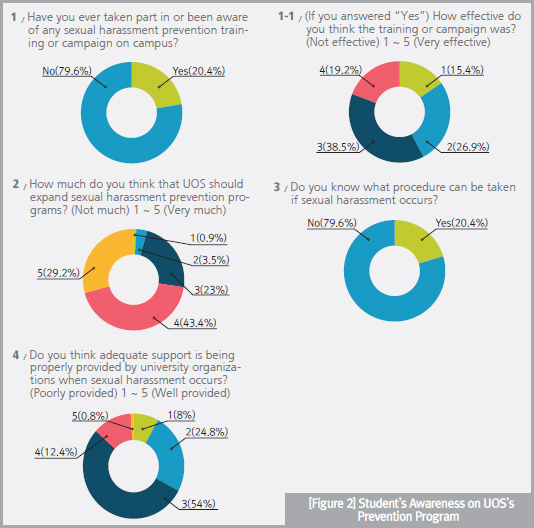
Insufficient Prevention and Protection at UOS
In order to prevent on-campus sexual harassment, UOS has regulations on the prevention of sexual violence.
UOS mandates its professors and officials to complete sexual harassment prevention training twice a year. According to Sang-soo Kim, it is not quite effective considering that the training is only a few hours a year, and there is no supplementary or punitive article for cases in which trainees do not complete their yearly training session. “Quite a few professors and officials skip the session because of their schedules, but nothing is done afterwards to them,” Kim said. “So they are actually not taking any periodic training.”
In addition to insufficient sessions, the quality of training has also been brought into question. Since current training sessions take the form of mid-to-large scale lectures, a trainer cannot ensure that every single trainee has understood what the course is trying to explain. “The effect of training is much greater when it is done in smaller groups or one-on-one, if possible,” said Kim. “A trainer can more easily personalize the topic and make sure that a trainee has understood what is being explained.”
What is worse is that such insufficient training is not even provided to general students, who form a large majority of the UOS community. Except for a non-mandatory training session during freshmen orientation, students do not take any regular training for sexual harassment prevention. As seen in Figure 2, about 80 percent of the students answered on the survey that they have neither completed nor spotted any sexual harassment prevention program at the UOS campus. More than 40 percent of the students who completed training thought that it did not help prevent incidents.
Also in the same Figure 2, more than 70 percent of students answered that training programs to prevent sexual assault should be greatly expanded. To a question asking what would be needed to prevent on-campus sexual assault, students’ answers included education and training, improving awareness, and campaigns. Kim, as an official who conducts these preventive activities, also agreed that more effort is required in order to reduce on-campus sexual harassment.
As an alternative, Kim suggested assigning sexual harassment prevention training as a mandatory course to all students, which would mean that students would have to complete the course in order to graduate. As an instance of such a policy, in March 2016 Seoul National University decided to make it compulsory for students to complete sexual violence prevention training. Kim said this kind of approach can help enhance students’ awareness level.
As well as prevention, protection of victims is also an important issue in the process. The Ministry of Gender Equality and Family has even highlighted victim protection as one of the three points of their Sexual Violence Prevention Policy, along with prevention and prosecution. Ms. A, the sexual harassment victim mentioned above, said that she could not report the incident of harassment against her because she did not know exactly how to do so. Furthermore, she was worried that the disciplinary process and the school’s response could affect the rest of her campus life. The Student Counseling Center sympathizes with this concern about protection, especially regarding what happens after the disciplinary procedure has been completed. Due to the practical limitations of capability of the center, Kim commented, “We are deeply worried that we cannot actually protect all the victims perfectly. You can say that giving the assailant a restraining order is the best we can do as of now.”
The main reason for unsatisfactory prevention and protection is, Sang-soo Kim said, lack of human resources. Because there is no counselor dedicated solely to sexual issues, officials at the Student Counseling Center are currently taking on the job of Gender Equality and Disability Support, too. This situation lays an excessive workload on the officials and makes it impossible for them to expand any program for sexual harassment prevention or protection. The Gender Equality Office does not even have a separate workspace, its officials working in the Student Counseling Center.
Expertise in sexual harassment issues is another problem. “We lack specialists,” said Kim. Kim himself is also only trained to deal with typical counseling, not with sexual violence cases. He had to start studying on his own and get some basic training in order to do this kind of specialized counseling work, after he was moved to his current post.
This problem, Kim said, can be solved by hiring an expert dedicated to sexual assault issues. However, UOS has not assigned any additional budget to do so, and the Student Counseling Center is currently incapable of hiring an expert in sexual assault issues. Kim already has been requesting such an expert for years, only to receive unsatisfactory answers. “UOS seemingly agrees with the idea, but it is just a matter of priority,” Kim said. “But I do not think my efforts are being wasted. It will cause gradual changes and get results someday.”
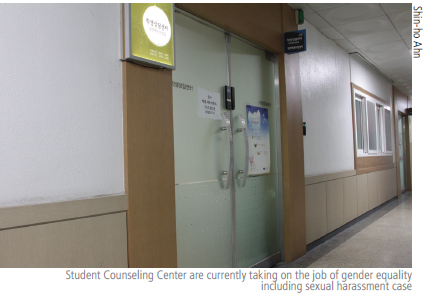
Guide for the UOS Community
Sang-soo Kim also gave guidance about things that general students, faculty and campus workers can do to prevent sexual harassment, which can be just as important as education or discipline. Kim recommends that people be more attentive even to mild cases of harassment and to resolutely correct the problem. He said that in public circumstances, immediate intervention can prevent further harassment. “It is not that hard to change the situation when you observe problematic acts or speech. If someone utters inappropriate or sexually-intended words or engages in problematic behavior, and if you think it’s wrong, all you need to do is just softly warn the person and urge him or her to apologize.”
Kim emphasized that the most important role in the situation is given to people around the potential victims and offenders, saying that their intervention can change the current trends. He said that if the surrounding people repeatedly intervene in every single case, it can have a preemptive effect that makes potential assailants think twice.
According to the Korean online news provider Nocut News, in 2011 the Korea Sexual Violence Relief Center (KSVRC), a women's activist organization that assists and supports sexual violence survivors, analyzed the previous 20 years of counseling cases and asserted that sexual harassment was mostly hiding in plain sight. So, counselors of the KSVRC urged that we need to deal with sexual harassment more seriously, and that we should check and revise improper group culture which is vulnerable to sexual harassment.
During the survey and interviews, many suggested that a protocol or guidelines for reporting sex crimes should be widely announced in case any incident occurs. Counselor Kim said that the most effective way is to contact the Student Counseling Center right away, because the longer you avoid treating your wounds, the deeper they reach into your mind, and the bigger the pain will grow. He urged that the primary goal of the Counseling Center is to heal the emotional wounds of victims, so whoever has suffered from such an event should stop hesitating and visit the center to ask for help.

We greatly appreciate all of the help we have received from interviewees and survey participants. A lot of school members gave us a tremendous amount of help, even considering the delicate character of this subject.
Shin-ho Ahn
ash906@uos.ac.kr
Jeong-ho Shin
jhshin2110@uos.ac.kr

